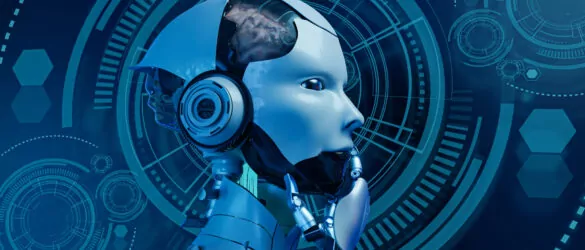Many businesses, especially SMEs, often overlook the importance of cybersecurity. They believe their companies aren’t appealing targets for cybercriminals or that their technologies are too advanced to hack. However, while digitalization is at an all-time high, data breaches are becoming more frequent and impactful than ever. As a result of this unfortunate trend, the average global cost of a data breach rose to $4.45 million in 2023, up from $2,054 in 2001.
Artificial intelligence (AI) technologies can soon become game-changers in cybersecurity due to their many advantages over humans. In fact, Statista reports that the market for AI in cybersecurity will grow in the coming years, from around $24 billion in 2023 to roughly $134 billion by 2030.
Our Inoxoft team develops AI-powered solutions for various business needs and is always ready for complex cybersecurity challenges. Based on our experience and expertise, we created this article to explore the growing threat of cybercrime, the potential benefits of integrating AI into your cybersecurity measures, and how this technology can transform your business for good. Keep reading to learn more!
- How AI Boosts Cybersecurity
- AI Techniques Applied in Cybersecurity
- Deep Learning for Cyber Attack Prediction
- Machine Learning for Threat Detection
- Examples of How AI Can Be Used in Cybersecurity
- Threat detection and prevention
- Responding incidents
- Searching for hidden treats
- Benefits of AI in Cybersecurity
- Automated Security Operations
- Straightening Cybersecurity Staff
- Enhancing Speed and Efficiency
- Improving Accuracy in Threat Identification
- Challenges and Limitations of AI in Cybersecurity
- Reliance on Human Expertise
- Adversarial Attacks
- Data Privacy Concerns
- Dependence on Quality Data
- AI Cybersecurity Tools that Can Be Used for Preventing Crimes
- Anomaly Detection
- Vulnerability Assessment and Patching
- Security Information and Event Management (SIEM)
- Threat Hunting
- Top AI Cybersecurity Companies and Startups
- The Future of AI in Cybersecurity
- How Inoxoft Can Empower Your Company with AI-Based Solutions
- Conclusion
How AI Boosts Cybersecurity
As everything goes digital, AI cybersecurity threats are increasing daily. IT security professionals now face the critical task of stopping these attacks and protecting billions of dollars in annual savings. How can AI assist people in managing these risks?
AI-powered cybersecurity provides an effective solution for continuous monitoring, analyzing, detecting, and responding to threats in real-time. AI systems process vast amounts of data to find patterns that indicate potential dangers and scan networks for vulnerabilities to prevent common attacks. They can also prioritize risks, respond to anomalies, and block unauthorized access.
Besides, AI algorithms help with the early detection of malware and automate repetitive tasks, which reduces human error. Statistics reveal that many companies have already adopted AI to support their cybersecurity efforts, with 55% of organizations planning to implement generative AI cybersecurity solutions this year.
AI Techniques Applied in Cybersecurity
With cyberattacks growing more complex, traditional security methods often need to be revised. Let’s discuss two of the most popular AI techniques used in cybersecurity, which give teams a better chance to predict and detect new and changing threats.
Deep Learning for Cyber Attack Prediction
Deep learning, a branch of AI, trains neural networks to find complex patterns and make decisions based on the data they receive.
How It Works: Deep learning systems predict cyber-attacks by analyzing large amounts of data from various sources. For instance, it can sift through data from network logs, user behavior, and threat feeds to find signs of potential risks. It can also analyze malware to spot new variants or unknown exploits.
Machine Learning for Threat Detection
Machine learning, another popular branch of AI, mimics human thinking and allows computer systems to learn from experience without needing specific programming.
How It Works: Machine learning algorithms look for patterns in network traffic or user behavior that might hint at potential threats. They use past experiences to spot unusual activities and flag possible risks. Additionally, machine learning can non-stop monitor network traffic to detect signs of a distributed denial-of-service (DDoS) attack.
Examples of How AI Can Be Used in Cybersecurity
Forbes reports that 76% of enterprises have already prioritized AI and ML in their IT budgets, stressing how valuable these technologies are nowadays. Let’s look at some real-life AI in cybersecurity examples.
Threat detection and prevention
As we’ve already explained, AI threat detection software uses machine learning to sift through data and spot patterns that might be security threats.
In the real world, banks can use AI to monitor user behavior and catch unusual activities. For instance, if someone’s account suddenly starts making multiple international transfers from an unexpected location, AI can flag this as suspicious. The system then alerts the bank, allowing it to investigate and potentially stop fraud in its tracks.
Responding incidents
AI algorithms can make incident response a lot more efficient. This software prioritizes alerts, suggests solutions, and even handles some responses automatically, reducing the time needed to deal with incidents.
Imagine a healthcare organization hit by a ransomware attack. An AI-driven incident response system can quickly isolate affected hardware, block malicious IP addresses, and begin data recovery, minimizing the attack’s impact and helping get things back to normal as soon as possible.
Searching for hidden treats
Another thing AI excels at is spotting hidden threats. By analyzing network traffic, user behavior, and system logs, the software finds signs of trouble that traditional security tools might miss. Deep learning helps it catch even the smallest anomalies.
In an enterprise setting, AI can analyze employee emails and network activity to detect signs of a phishing attack. For example, if they receive a letter that looks legitimate but contains a malicious link, AI can flag it based on patterns from past phishing attempts. This proactive detection helps prevent data breaches and keeps credentials safe.
Benefits of AI in Cybersecurity
Today’s security teams deal with a lot of problems: a growing number of threads, poor-quality data, and complex software infrastructure. These issues make it difficult to protect user information, manage access, and quickly respond to cyberattacks. AI-powered solutions can help with all these problems, and here’s how:
Automated Security Operations
Handling security operations can be challenging and labor-intensive, particularly for organizations with limited resources. AI-based cybersecurity tools like vulnerability scanners, patch management systems, and network monitoring can take care of many routine jobs.
By the way, 10-25% of banking tasks are already automated using AI. With intelligent automation businesses allow their security teams to focus on more important problems and reduce the chances of human errors.
Straightening Cybersecurity Staff
Even if your security team is already proficient, AI can transform it into something more – an unbeatable force. For example, AI delivers real-time insights and recommendations based on the latest threat intelligence, keeping the team a step ahead.
Also, AI tools give cybersecurity staff more time to concentrate on high-level strategy and complex problem-solving with the most up-to-date data. Equipped with powerful tools that improve their skills, they become more adept at defending organizations against cyber threats.
Enhancing Speed and Efficiency
AI-powered cybersecurity systems work faster and more efficiently than traditional methods. They can instantly check thousands of devices for weaknesses – a task that would take humans days to complete.
Moreover, AI can spot patterns that humans might miss, resulting in better detection of threats. According to a Forbes Advisor survey, 64% of businesses believe using AI will significantly boost their productivity, showing increasing trust in AI’s ability to change how businesses operate.
Improving Accuracy in Threat Identification
AI for cybersecurity uses machine learning models that continually learn from past incidents, which helps them better identify potential threats. Also, they adapt and self-correct over time, improving their accuracy in spotting anomalies and threats.
According to a study by PwC, AI can improve data accuracy by up to 80%. This self-correcting nature of AI gives organizations very reliable cybersecurity defense mechanisms, allowing them to respond quickly to emerging threats.
Challenges and Limitations of AI in Cybersecurity
While the integration of AI into cybersecurity holds great promise, it also presents certain challenges and limitations that organizations must address. Here are some of them.
Reliance on Human Expertise
Many people wonder: will cybersecurity be replaced by AI? The simple answer is no, it won’t. While AI algorithms can greatly simplify cybersecurity processes, human intervention still remains very important. Attackers can easily manipulate AI inputs and infect systems with malicious code, leading to unnecessary computations that drive up operational costs.
Without proper investment in the human side of cybersecurity, organizations risk their reputation, trust, and financial stability.
Adversarial Attacks
In simple words, adversarial attacks are manipulations that fool machine learning models into making mistakes. They exploit how systems learn and work, intending to damage the software’s effectiveness. Criminals create so-called adversarial examples, which are subtly altered input data designed to deceive AI systems.
Also, AI cybersecurity risks include the possibility of malicious actors exploiting AI systems to launch more effective attacks. To defend against these attacks, teams use adversarial training, defensive distillation, and feature squeezing. However, balancing AI performance with security continues to be a challenge.
Data Privacy Concerns
BlackBerry’s research shows that 75% of organizations worldwide support banning ChatGPT and other generative AI applications in the workplace. CEOs are advocating for the ban due to concerns about AI apps being unsecured and posing threats to the corporate IT environment.
The primary worry is data privacy. Companies fear that storing data on external servers could lead to leaks, which would compromise the security of the organization and its clients. Despite these concerns, many businesses still want to know how generative AI can be used in cybersecurity to boost threat detection and response capabilities.
Dependence on Quality Data
AI algorithms need a constant supply of data to function optimally. With the vast amount of big data available, organizations often struggle to figure out which datasets are relevant and reliable for solving their security problems.
Also, for AI to work correctly, the data must be of high quality. Although the algorithm can analyze it quickly, it cannot differentiate between false and accurate information. Poor-quality data can lead to incorrect conclusions since it is often considered the main source of truth in decision-making.
AI Cybersecurity Tools that Can Be Used for Preventing Crimes
What are the top AI tools for preventing cyber crimes? A quick online search will reveal a significant knowledge gap on this topic. Although there’s plenty of information on AI automation, details about security-specific tools are rare. That’s where this section comes in.
Anomaly Detection
As the name implies, anomaly detection tools can detect unusual patterns or behaviors within a system that might be a sign of malicious activity. These tools use machine learning to understand what typical activity looks like and then watch for anything that deviates from this norm.
- PayPal has developed its own anomaly detection system that helps prevent fraudulent transactions. It analyzes transaction data, looking for patterns that stand out as unusual. For instance, if a user suddenly makes a large purchase in a different country, the system flags it for further investigation by cybersecurity staff.
Vulnerability Assessment and Patching
Vulnerability assessment tools scan systems to find weaknesses or vulnerabilities that hackers could exploit. Once identified, patching tools (like Ivanti’s patch management software) can automatically apply fixes to these vulnerabilities, protecting the system.
- Tenable Nessus is a popular vulnerability assessment tool. It scans computers, servers, and other devices to find security holes, like outdated software or misconfigured settings. It then provides detailed reports on these issues.
Security Information and Event Management (SIEM)
SIEM software collects and analyzes data from different sources within an organization’s IT environment, providing real-time insights into security gaps through comprehensive monitoring, event correlation, and automated responses.
- Splunk is a well-known SIEM solution. It gathers logs and event data from different systems, such as servers, network devices, and applications. Using AI, Splunk analyzes this data to find unusual activities, like multiple failed login attempts or unexpected data transfers.
Threat Hunting
Threat-hunting tools help proactively address cyber threats that might evade current security measures. These systems use ML and AI to analyze large volumes of data and flag signs of advanced persistent threats (APTs) and other sophisticated attacks.
- CrowdStrike’s Falcon platform is a leading threat-hunting tool in the market. It analyzes data from endpoints (like computers and mobile devices) for indicators of compromise (IOCs), such as unusual file changes or network traffic. Security analysts use Falcon to find hidden threats and prevent serious security breaches.
Top AI Cybersecurity Companies and Startups
More and more cybersecurity companies are turning to AI and ML, making these technologies central to their offerings. We’ve put together a list of 5 promising AI cybersecurity startups and 5 established companies to help you understand what AI-powered cybersecurity partnerships can offer your business.
Palo Alto Networks, a US-based cybersecurity leader, provides a comprehensive suite of products, including firewalls and security management solutions. Their flagship product, Cortex, uses AI to help Security Operations Centers (SOCs) handle complex threats. Cortex integrates data from various sources like networks and cloud resources to detect sophisticated attacks that might be missed by other security tools.
2. Gomboc
Gomboc is a startup focused on developing an AI engine that provides precise and secure Infrastructure as Code. Updated every night, this engine assists security teams in applying cloud security policies and allows DevOps teams to make quick changes. Gomboc recently raised $5 million to expand its capabilities.
3. Fortinet
Fortinet is a leading AI cybersecurity company that stands out for blending network and security solutions into a unified system. The company’s extensive product lineup covers network security, data centers, and application protection. The Fortinet SecOps platform uses AI to constantly monitor and analyze network activity, helping detect threats across a wide range of sources, including email and cloud services.
4. Lakera
Lakera’s key focus is on protecting intelligent computing systems. The company helps businesses build secure AI applications and has developed Gandalf, a widely popular AI security game with millions of users. Lakera recently raised $10 million to further advance its AI security innovations.
5. Trellix
Trellix, which evolved from FireEye, is known for its advanced use of AI to improve threat detection and response. Trellix’s system filters out irrelevant alerts and accelerates how quickly the teams handle incidents. The company also offers a chatbot for customer support that provides fast answers, minimizing the need to search through documentation.
6. Qevlar AI
Qevlar AI focuses on improving the efficiency of Security Operations Centers (SOCs) through AI-driven automation. Its technology takes care of repetitive tasks, freeing SOC teams to focus on more important issues. The company recently raised €4,5 million in seed funding to develop its solutions further.
7. Zscaler
Zscaler leads in zero-trust security, providing a model that connects users to applications without traditional network barriers. The company uses AI and ML to boost its ability to protect data and handle emerging threats, including those related to generative AI and cybersecurity.
Radiant Security offers an AI-powered co-pilot for Security Operations Centers, designed to increase analyst productivity and accelerate threat detection. The company’s solution integrates via API and can cut analyst workloads by up to 95%. The company recently announced a $15 million Series A funding round to support its growth.
9. CrowdStrike
CrowdStrike is a top player in cybersecurity, offering solutions like endpoint protection and threat intelligence. The organization’s AI-based defense system, informed by extensive security data and expert insights, provides robust protection against various cyber threats.
10. Binarly
Binarly focuses on securing firmware and hardware components. Its tools use ML to detect vulnerabilities and malicious code in firmware, ensuring a secure supply chain. Binarly raised $3.6 million in Seed funding to expand its reach globally.
The Future of AI in Cybersecurity
ChatGPT, Dall-E, and other generative models have recently brought a lot of mainstream attention to AI, but cybersecurity has used the technology for quite some time. AI and ML have been important topics in the industry even before generative systems became popular.
As the cybercrime landscape grows and becomes more complex, we need more advanced tools to keep up with new threats. The role of AI is already significant, but how will AI affect cybersecurity in the coming years? Let’s find out:
- The AI cybersecurity market is projected to grow, from approximately $24 billion in 2023 to about $134 billion by 2030.
- AI will only get better at spotting sophisticated threats, like zero-day exploits and advanced persistent threats, improving its complex patterns analysis capabilities.
- AI tools will handle incident responses much faster, automatically isolating infected systems, applying patches, and even rolling back systems to safe states.
- As more devices connect to the Internet of Things, the latest developments in cybersecurity AI step in to secure them, fixing vulnerabilities in everything from smart homes to industrial systems.
- AI solutions will become more scalable and affordable, allowing even small businesses to implement advanced cybersecurity without extensive resources.
- AI will promote better sharing of threat data between organizations, helping everyone stay one step ahead of cybercriminals.
How Inoxoft Can Empower Your Company with AI-Based Solutions
At Inoxoft, our research and development team of 200+ specialists works hard to create smart solutions for various industries and help businesses use their data to achieve meaningful and impactful results.
With 10+ years in the market, we specialize in natural language processing, computer vision, neural networks, cognitive computing, and deep learning. Our team develops machine learning models, handles data engineering, and performs data analysis to support businesses in maximizing the benefits of AI.
Inoxoft also focuses on predictive analytics and chatbots, helping companies forecast future trends and improve customer service. Contact us to learn more about how we can help your company address the current challenges.
Conclusion
Intelligent technologies are the next big thing in business innovation, and AI’s impact on cybersecurity cannot be underestimated. It can analyze, detect, monitor, and respond to cyber threats much faster than humans. Moreover, AI systems can quickly go through large amounts of data to spot patterns that show potential threats or weaknesses in your cyber defenses.
AI-powered cybersecurity tools are a great help to security teams. They track behavior patterns, automate tasks, and quickly find unusual activities. This cuts down on manual work and reduces human error. More and more companies and startups are using AI for cybersecurity as a key part of their business offerings.
If you’re interested in implementing AI-enabled cybersecurity solutions or have any questions about how AI can benefit your organization’s security efforts, we invite you to contact Inoxoft. Reach out to us today to schedule a consultation with our cybersecurity specialists.
Frequently Asked Questions
How does AI handle evolving cyber threats?
AI fights cyber threats by finding patterns and suspicious activities that might indicate a problem. It analyzes loads of data in real-time and learns with each new threat it faces. This means AI can quickly identify new threats and adjust as attackers change their tactics. Also, AI speeds up responses, automating the process of finding and stopping attacks, which helps prevent damage before it happens.
Additionally, AI systems keep an eye on networks and devices, looking for any small changes that could signal an issue. They can even predict future threats by analyzing past data, allowing organizations to prepare for them beforehand.
How does AI enhance phishing detection?
AI makes it easier to detect phishing attempts by examining emails, websites, and messages for signs of scams. It uses machine learning to spot things like fake email addresses, strange links, or anything that looks off. AI keeps learning from new data, which helps it stay ahead of scammers who are always trying new tricks.
AI algorithms can also monitor user behavior online and notice if something seems unusual, like clicking a suspicious link. If something is wrong, the system warns users or blocks the scam attempt altogether. It also shares information about new threats with other systems, increasing security for everyone.
What role does AI play in endpoint security?
The role of AI in cybersecurity is to protect devices like computers, phones, and tablets from cyber threats. It monitors these devices 24/7, looking for anything unusual that might indicate an attack. AI is especially good at spotting new types of threats that traditional security software might miss.
Moreover, AI acts much faster than traditional software by automatically responding to threats, such as cutting off a compromised device or stopping harmful actions. It learns from new data and past attacks, constantly improving its ability to detect threats. With AI, organizations can protect their devices and data more effectively, reducing the chances of successful cyberattacks.
What is the impact of AI on security operations centers (SOCs)?
The impact of AI on cybersecurity is significant. AI systems make Security Operations Centers (SOCs) way more efficient and effective. Except for thread detection, these tools also automate many routine tasks like checking logs, freeing up analysts to focus on complex issues. This means SOCs can detect and respond to threats much faster, improving overall security.
Another way AI helps SOCs is by analyzing data from different sources to get a complete picture of security incidents. It helps manage large amounts of information, prioritize alerts, and make quick decisions, leading to faster responses and better protection against cyber threats.
Can AI help in securing cloud environments?
Yes, AI can help secure cloud environments by spotting threats, automating responses, and constantly watching over cloud resources. This helps organizations quickly detect and respond to attacks, reducing the risk of breaches and other security issues.
AI can also handle tasks like managing access and enforcing security policies, making sure everything stays protected. It adapts to new threats, learning from each incident to improve its abilities. AI also helps manage complex cloud environments, giving organizations better control over their security. By using AI, companies can strengthen their cloud security and protect sensitive data more effectively.

































